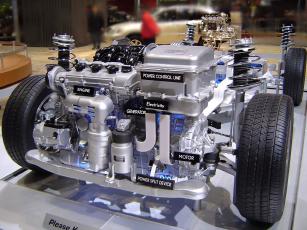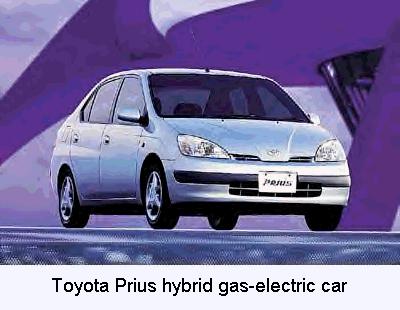
Home, Auto Repair Library, Auto Parts, Accessories, Tools, Manuals & Books, Car BLOG, Links, Index



Electric vehicle development has been taking some unique twists and turns lately. The main challenge to date has been battery development (or the lack thereof). A purely electric vehicle powered by batteries alone still cannot compete with gasoline powered vehicles in terms of cost, convenience or range. Most of the electric vehicles that have been marketed to date get less than 100 miles per charge with lead-acid batteries. Recharging time is still slow, and batteries eventually have to be replaced at considerable cost. A variety of "high tech" batteries have been developed that have much higher storage capacity and range, but costs are still too high to compete with gasoline-powered vehicles.
Many say hydrogen-powered fuel cells will ultimately make the electric vehicle practical. Fuel cells combine hydrogen and oxygen to make electricity and water vapor. It's clean, efficient power. As fuel cells continue to improve, their costs are coming down. But production-ready fuel cells are still several years away.
For more information about fuel cells, read Jim Motavalli's book "Forward Drive." This book covers in depth the latest advancements in fuel cells, batteries and electric vehicle development. The book is available at Sierra Club Books or Random House Publishing
Until fuel cells are ready, hybrid gasoline-electric technology seems to be the best near-term solution to reducing emissions and doubling fuel economy. Hybrid vehicles use a small gasoline or direct injection diesel engine for light load operation and to charge an onboard battery. An electric motor then provides additional power for acceleration and higher loads. Think of hybrids as "electrically supercharged" vehicles.
Operating strategies vary, but most use some combination of internal combustion and electric power to optimize fuel economy, performance and emissions.
The hybrid approach can deliver extremely high fuel economy and ultra low emissions without sacrificing driving range, convenience or driving performance. It also eliminates the need for an electrical plug and charging station to recharge the onboard battery, and it allows the use of a much smaller battery to reduce weight, cost and bulk.
The new Toyota Prius Hybrid represents the current state-of-the-art in production hybrid electric vehicles. The Prius, which goes on sale late this summer in the U.S., combines a 1496 cc 70 hp gasoline engine with a 40 hp electric motor to deliver 52 mpg in the city and 45 mpg on the highway, with a potential driving range of almost 700 miles on a single 13.2 gallon fillup. The base price is $19,995.


Exhaust emissions from the Prius are extremely low. Toyota says carbon monoxide (CO), hydrocarbon (HC) and oxides of nitrogen emissions are reduced 90 percent. This allows the vehicle to exceed California's Super Ultra Low Emission Vehicle (SULEV) standards.
Power output from the gasoline engine is split between the drive wheels and a generator. The generator, in turn, is used to run the electric motor and/or to recharge the 40 7.2 volt sealed Nickel-Metal Hydride (NHM) batteries.
The electric motor is a permanent magnet design which needs no maintenance because its "no touch" internal components do not wear. It produces its maximum power of 30 kilowatts (40 horsepower) from 940 to 2000 rpm, and maximum torque of 31.1 kg-m (225 lb./ft.) from 0 to 940 rpm.
The U.S.-spec Prius will benefit from a more powerful, more compact, and lighter battery pack. Peak battery-pack power has been increased by 20 percent to 25 kilowatts (kW), or 34 horsepower. Each of the 38 modules within the pack is only three-quarters of an inch thick and 20 percent lighter in weight than the units in the Japan-version Prius. The new lighter batteries will reduce battery pack volume by 40 percent and will allow for more cargo area in the trunk.
Operation of the hybrid combination is seamless and virtually imperceptible to the driver and passengers. It five main operating modes are:
1. When pulling away from a stop or under a light load, only the electric motor powers the vehicle.
2. For normal driving, a combination of gasoline and electric power is used.
3. Under full-throttle acceleration, the electric motor receives additional power from the 40 batteries.
4. During deceleration or braking, the electric motor functions as a generator to recharge the batteries.
5. The batteries are regulated to maintain a constant charge. When charging is needed, power from the engine is used to drive the generator. This eliminates the need for an external charger or power connection.
The key to the Toyota Prius system is a power split device in the transmission which sends engine power either directly to the wheels or the electric generator. The generator, in turn, powers the electric motor and recharges the batteries. The power split device uses a planetary gear to constantly vary the amount of power supplied from the engine to either the wheels or generator. The electronically controlled transmission controls engine speed, generator output and the speed of the electric motor to handle changing driving modes.
The system is designed to keep the engine running within its most efficient rpm range. When increased driving loads lug down the engine's speed, the control system shuts off fuel to the engine and kills the engine. The electric motor then takes over and provides 100 percent of the driving power. If additional power is needed, the engine is restarted and adds its power output until the extra power is no longer needed. At that point, the electric motor cuts out and the engine resumes its light load operation in its optimum speed range.
The hybrid drivetrain has proven itself to be trouble-free, says Toyota. The car has been on sale in Japan since December 1997, and has sold more than 35,000 units.
Standard equipment includes Anti-Lock Brakes, automatic transmission, climate-control air conditioning, power windows, door locks and mirrors, AM/FM/cassette stereo, an eight-year/100,000-mile battery and hybrid system warranty, and free seven-day/24-hour roadside assistance.
Toyota crossed the symbolic milestone of 15 million hybrid vehicles sold since the 1997 launch of the Prius, the first full hybrid mass-produced car.
Now offered on 44 individual models across a wide range of size and body types, Toyota's hybrid electric technology has reduced CO2 emissions by more than 120 million tonnes worldwide. Toyota currently offers 20 different Hybrid Electric Vehicles (HEV) models in their Toyota and Lexus brands, which in 2019 accounted for 52 percent of total sales volume, and 63 percent in West Europe.
In Europe, the company has sold over 2.8 million hybrid cars, allowing it to be a leading automaker towards EU CO2 reduction targets of 25g/km in 2020 and 2021.
Toyota hybrid technology not only reduces global warming CO2 emissions, it also allows drivers to cover more than 50 percent of their journeys in and around the city in zero emission mode, offering an affordable way to improve air quality in urban cities.
The decision to develop hybrid electric vehicles started over 25 years ago when Takeshi Uchiyamada led a team to develop a car for the 21st century, one which would reduce greenhouse gas emissions and other harmful pollutants. The first-generation Prius was launched in 1997 around the time of the Kyoto Protocol signing, which gave new momentum to the environmental movement.
Although hybrid vehicles have been a big sucess for Toyota, they believe the future will be a mix of Plug-in Hybrid vehicles (PHEV), Fuel Cell (FCEV) and Battery Electric (BEV) vehicles. By 2025, Toyota plans to launch 40 new or updated electrified vehicles, including at least 10 Zero Emission (ZEV) vehicles.
 More Hybrid Vehicle Articles:
More Hybrid Vehicle Articles: Click Here to See More Carley Automotive Technical Articles
Click Here to See More Carley Automotive Technical Articles